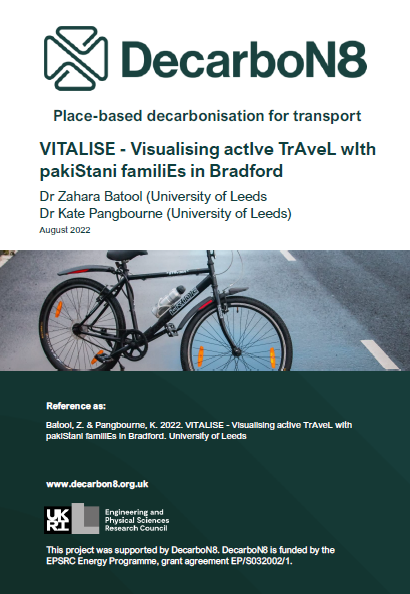Visualising active travel with Pakistani families in Bradford
Authors: Zahara Batool, Kate Pangbourne (2022)
PDF (52 pages, 4 MB)
This document reports on a Photovoice (PV) based Participatory Action Research study designed to investigate barriers to active travel in Bradford’s Pakistani heritage community. It is also aimed to investigate the use of PV to encourage critical consciousness of active travel (AT).
Key Findings
This research used Photovoice (PV) based Participatory Action Research to investigate barriers to active travel in Bradford’s Pakistani heritage community. It is also aimed to investigate the use of PV to encourage critical consciousness of active travel (AT). The study recruited eight families from different areas of Bradford.
Combating social norms
Cognitive biases and social norms are found to influence people’s travel choices. People find it difficult to break the car use habit which provides protection against cold weather, convenience, and the perception of saving time. For the older generation participants, lack of motivation could be an additional barrier due to their health condition. Considering the economic pressure and family and work responsibilities, opting for walking and cycling may not be considered practical unless people are incentivised for making these changes. One such incentive would be overcoming social and cultural barriers to change. Countering stereotyping through integrated inclusive awareness campaigns could prove beneficial. Many of the community members may perceive cycling as an activity for healthy, fit, high-income White people.
For women, lack of community support could be the biggest challenge. Fear of being judged can dissuade them from walking and cycling independently. Men face less judgment but are likely to adopt and invest in unsustainable active travel behaviours under peer pressure. There is a growing concern that teenage boys will likely get into a culture of owning fancy cars. The city is famous for its massive car culture. There is a potential of driving recklessly due to a lack of awareness and loss of other leisure activities for young boys in Bradford.
Overcoming environmental barriers
The analysis highlighted local barriers in the environment which need addressing especially in low-income areas. These include fly tipping, heavy traffic and poor driving culture, and lack of active travel infrastructure. In general, there is a perception that Bradford as a city isn’t safe.
Some key suggestions include improving street lighting, stricter enforcement to control fly-tipping and introducing segregated and well-connected active travel infrastructure in the city. Cycle lanes are not likely to work unless these lanes are segregated from traffic e.g., by planting to avoid traffic related air pollution. Currently, the lanes are considered a safety risk, adding pressure to the city’s traffic, and exposing people to air pollution. Segregated cycle lanes may also attract less confident cyclists and help address potential social barriers experienced by some groups such as women concerned about men staring.
Promoting change
The role of peer support is fundamental to support people to make use of available facilities and enable change. The participants expressed living in proximity to White population groups influence active travel behaviours. Hence, the study’s key recommendation is to foster cohesion with the White community and promote local role models. Asian activists (especially women) can play a vital role, women are often more active and looking for opportunities to improve their and their family lifestyles. Participatory techniques like Photovoice offer an opportunity to break the status quo for those who are struggling to make a change by raising their social consciousness.

